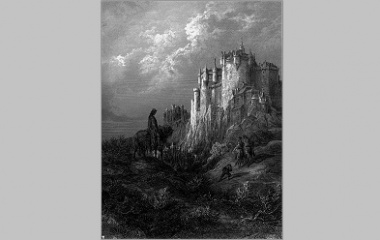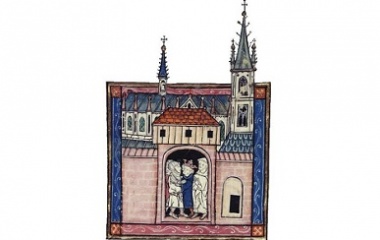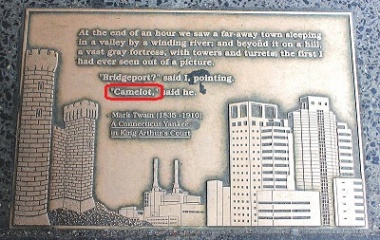Camelot was a place which prided itself on chivalry, friendship and love, but ironically, what brought about the ruin of the kingdom and its great leader, King Arthur, was the cruel betrayal of his heart.
What Is Camelot?
Camelot is a fictional, castled city in the Kingdom of Logres ruled by King Arthur. Believed to be located in Great Britain, it is the home of the legendary round table in the Arthurian legends. The city of Camelot is described in romantic literature as being situated next to a river and surrounded by forests and fields. Within its walls, a beautiful cathedral called St. Stephens was said to exist.
Origin
According to sources, reference is first made to Arthur, the King of Camelot, in a Welsh poem by the medieval poet, Aneirin in 594 AD entitled Y Gododdin. In 830 AD, Arthur is mentioned in the History of the Britons, written by Nennius.
Mention of Camelot first appears in 12th century French romance novels. It appears in the poem Lancelot, the Knight of the Cart by Chrétien de Troyes in the 1170s. A more detailed description appears in the 13th century in a series of French literature called the Vulgate and Post-Vulgate cycles. Researcher Norris Lacy asserts the Vulgate cycles were composed between 1215 and 1235 by an anonymous group of authors. Here, Camelot is depicted as the main city in Arthur’s realm. Lacy alleges the Post-Vulgate cycles were also authored by an anonymous author or group of authors, and here the literature describes Camelot in greater detail, including the adventure and fantasy element of the myth.
Camelot’s Location
Though Camelot is believed to be a fictitious place, much speculation has nonetheless been made about where it may have been situated.
Chrétien de Troyes and author Geoffrey of Monmouth believed Camelot may have been located in Wales, in Caerleon. Since Arthur was considered to be a Romano-Briton and the Welsh are direct descents of the Romano-British, this may add plausibility to the Caerleon claim. Another Welsh contender for the location of Camelot is the fictitious town of Carduel, which was based on the town of Carlisle.
In Sir Thomas Malory’s book, Morte d’Arthur, Camelot is purported to be in Hampshire, in a town called Winchester. Winchester Castle has displayed a round, wooden table for hundreds of years, with the names of King Arthur and 24 of his knights painted on it. The town of Winchester was the capital and court of King Alfred the Great in the 9th century. The king was said to be a great warrior, wise leader, law maker and great statesman – the traits also synonymous with King Arthur.
Another potential location in the UK is Cadbury Castle in Somerset County, according to antiquary John Leland. Archeological findings at the site indicate it was a well-fortified location. Evidence points to the inhabitants being wealthy and engaging in trade, possible affirmations that it was the castle of a Dark Ages king. Two towns existed in Roman Britain called Camulodunum, known in the modern day as Colchester and Outlane. Camulodunum may have been the source of the name Camelot.
Early Camelot
The Vulgate cycles mention Joseph of Arimathea visiting Camelot, bringing the Holy Grail with him. There, he was said to convert thousands of the inhabitants to Christianity and had the St. Stephens church built.
King Arthur’s Camelot
Camelot’s meadows were sufficiently large to host knightly tournaments. When the frequent tournaments were held, stands would be built for the numerous spectators. One of the stands was allegedly 1.5 miles in length! No definitive descriptions exist of the actual size of the town or its facilities, but during one particularly lavish court, the majority of the nobles could not be housed in Camelot, and were instead housed in the fields in tents and pavilions. The city’s defenses must have been formidable as they survived many wars, including invasions by the Saxons and Cornishmen. Camelot would have been at its peak when the quest for the Holy Grail began in approximately 453 AD.
The Round Table
The Vulgate cycles discuss the quintessential object in Arthurian legend, the round table, in detail. The text asserts the round table was a wedding gift from Guinevere’s father, King Leodagan. One hundred knights were already part of the round table at that stage. The remaining 50 members were chosen by Merlin, on Arthur’s behalf, to bring the number to the full contingent. The knight’s names were engraved on their chairs, bar one chair, which was referred to as the perilous chair, which would be filled by a great knight. The prestigious chair came to be filled by Sir Galahad.
The Betrayals of Camelot
Though the premise of Camelot is graciousness, chivalry and perhaps piety, these ideals were not always upheld. It is no surprise that the diversion from these ideals was the ubiquitous scourge of a love betrayal. Queen Guinevere’s affair with Lancelot causes Arthur to start a war with him. During the war between Arthur and Lancelot, the kingdom is entrusted to the king’s son, Mordred. Mordred betrays his father and takes over the castle in his absence. The king tries to kill Mordred and mortally wounds him. Mordred then strikes a deathblow to Arthur and kills him.
Modern References
In the 15th century, Sir Thomas Malory, in his book Morte d’Arthur, writes about Camelot and the Arthurian legends. His work influenced writers such as Alfred Tennyson, Mark Twain and John Steinbeck.
In the 20th century, the name Camelot was used to describe the presidency of John F Kennedy after his death.
Camelot and Magic
The magical themes associated with Camelot could be closely linked to Pagan traditions at the time. The spread of Christianity perhaps swayed authors to include the mix of the old and new ways in the Arthurian legends. Elements of both Christianity and Paganism were needed to bring the story’s mains themes – like good, evil and magic – to the fore, and are central in creating the conflict needed in any good story.
Over the love of a woman, many irrational thoughts, decisions and actions have arisen in myth and in the real world. The fragile hearts of man may become fortified with cynicism and retaliation, but if only King Arthur could have maintained his original ideals, perhaps his mythical kingdom would have continued and his heart remained whole through emotional fortitude rather. Or would that be akin to magic?










